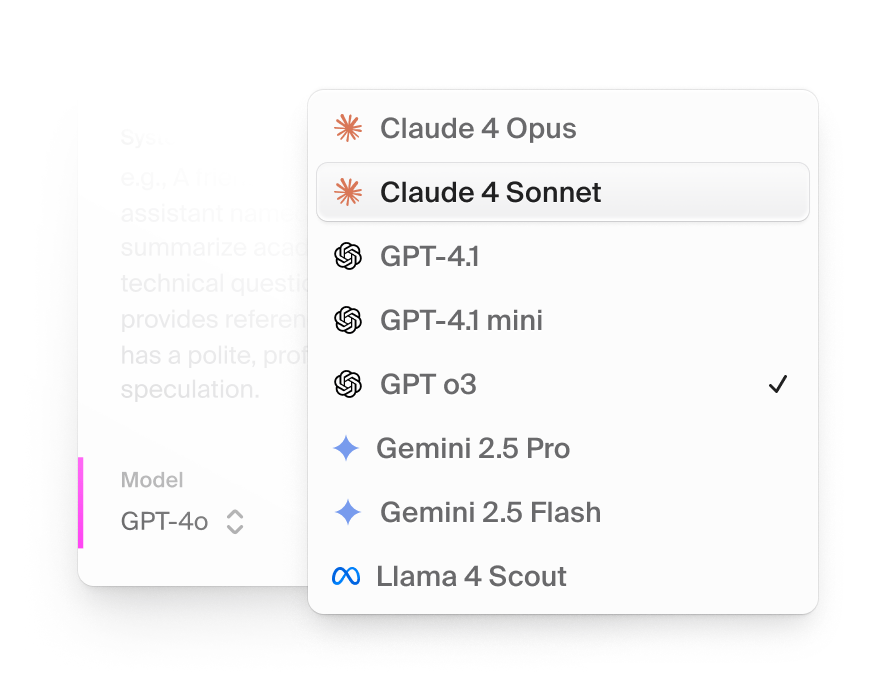Choosing the right model is essential to building effective agents. This guide
helps you evaluate trade-offs, pick the right model for your use case, and
iterate quickly.

Key considerations
- Accuracy and output quality: Advanced logic, mathematical problem-solving,
and multi-step analysis may require high-capability models.
- Domain expertise: Performance varies by domain (for example, creative
writing, code, scientific analysis). Review model benchmarks or test with your
own examples.
- Context window: Long documents, extensive conversations, or large
codebases require models with longer context windows.
- Embeddings: For semantic search or similarity, consider embedding models.
These aren’t for text generation.
- Latency: Real-time apps may need low-latency responses. Smaller models (or
“Mini,” “Nano,” and “Flash” variants) typically respond faster than larger
models.
Models by task / use case at a glance
| Task / use case | Example models | Key strengths | Considerations |
|---|
| General-purpose conversation | Claude 4 Sonnet, GPT-4.1, Gemini Pro | Balanced, reliable, creative | May not handle edge cases as well |
| Complex reasoning and research | Claude 4 Opus, O3, Gemini 2.5 Pro | Highest accuracy, multi-step analysis | Higher cost, quality critical |
| Creative writing and content | Claude 4 Opus, GPT-4.1, Gemini 2.5 Pro | High-quality output, creativity, style control | High cost for premium content |
| Document analysis and summarization | Claude 4 Opus, Gemini 2.5 Pro, Llama 3.3 | Handles long inputs, comprehension | Higher cost, slower |
| Real-time apps | Claude 3.5 Haiku, GPT-4o Mini, Gemini 1.5 Flash 8B | Low latency, high throughput | Less nuanced, shorter context |
| Semantic search and embeddings | OpenAI Embedding 3, Nomic AI, Hugging Face | Vector search, similarity, retrieval | Not for text generation |
| Custom model training & experimentation | Llama 4 Scout, Llama 3.3, DeepSeek, Mistral | Open source, customizable | Requires setup, variable performance |
Hypermode provides access to the most popular open source and commercial
models through Hypermode Model Router documentation. We’re
constantly evaluating model usage and adding new models to our catalog based
on demand. Get started
You can change models at any time in your agent settings. Start with a
general-purpose model, then iterate and optimize as you learn more about your
agent’s needs.
- Create an agent with GPT-4.1 (default).
- Define clear instructions and connections for the agent’s
role.
- Test with real examples from your workflow.
- Refine and iterate based on results.
- Evaluate alternatives once you understand patterns and outcomes.
Value first, optimize second. Clarify the task requirements before tuning
for specialized capabilities or cost.
Comparison of select large language models
| Model | Best For | Considerations | Context Window+ | Speed | Cost++ |
|---|
| Claude 4 Opus | Complex reasoning, long docs | Higher cost, slower than lighter models | Very long (200K+) | Moderate | $$$$ |
| Claude 4 Sonnet | General-purpose, balanced workloads | Less capable than Opus for edge cases | Long (100K+) | Fast | $$$ |
| GPT-4.1 | Most tasks, nuanced output | Higher cost, moderate speed | Long (128K) | Moderate | $$$ |
| GPT-4.1 Mini | High-volume, cost-sensitive | Less nuanced, shorter context | Medium (32K-64K) | Very Fast | $$ |
| GPT o3 | General chat, broad compatibility | May lack latest features/capabilities | Medium (32K-64K) | Fast | $$ |
| Gemini 2.5 Pro | Up-to-date info | Limited access, higher cost | Long (128K+) | Moderate | $$$ |
| Gemini 2.5 Flash | Real-time, rapid responses | Shorter context, less nuanced | Medium (32K-64K) | Very Fast | $$ |
| Llama 4 Scout | Privacy, customization, open source | Variable performance | Medium-Long (varies) | Fast | $ |


